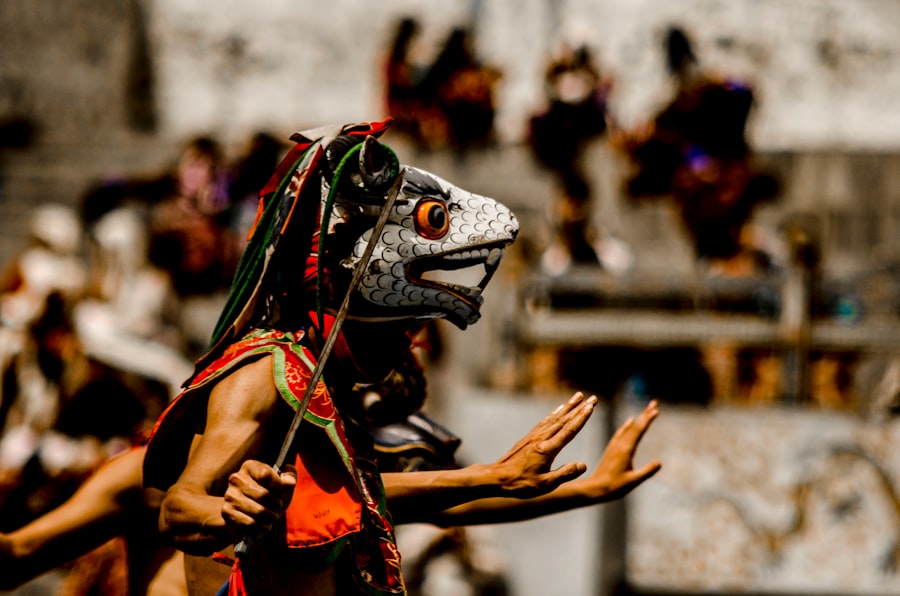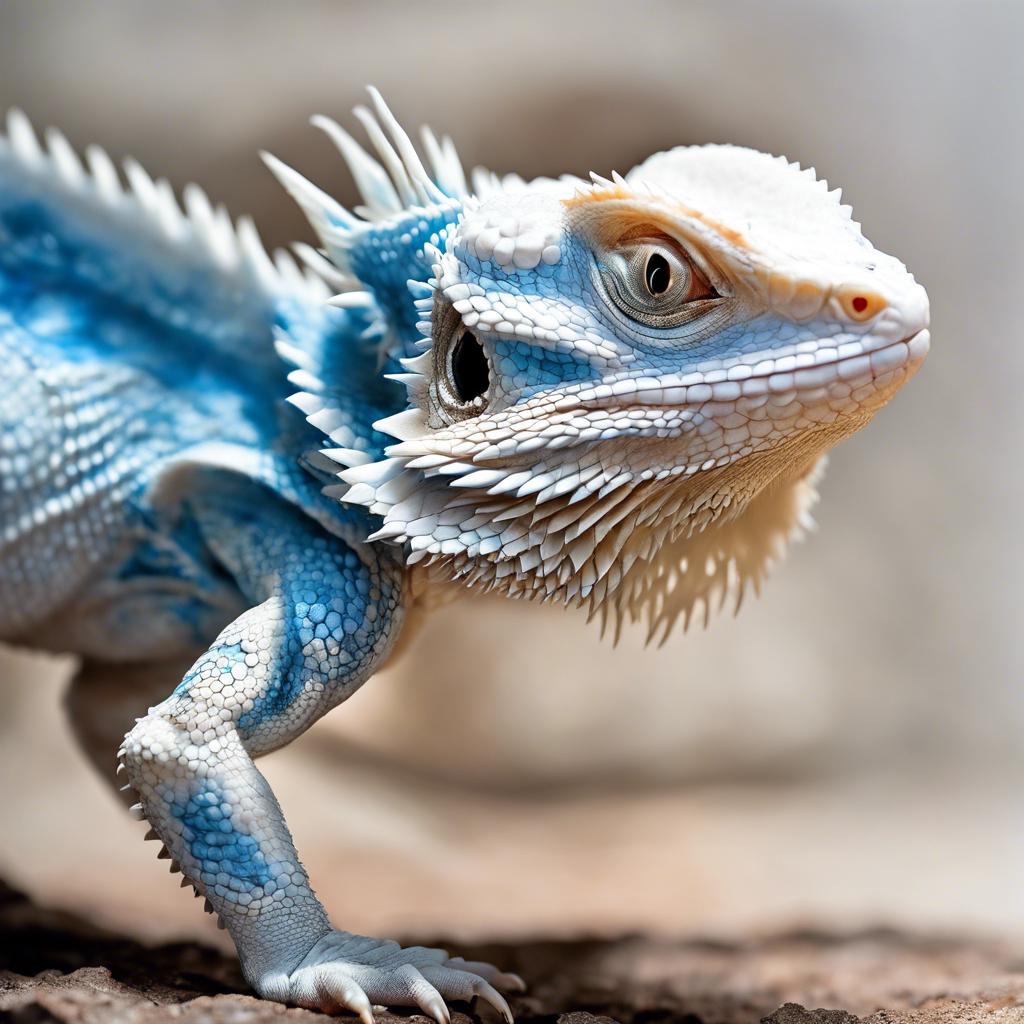Blue Flame Albino Bearded Dragons are a popular choice among reptile enthusiasts as pets. These unique creatures are a variation of the common bearded dragon, but with a striking blue coloration. They are known for their vibrant blue scales and stunning appearance, which sets them apart from other bearded dragon morphs.
Blue Flame Albino Bearded Dragons have gained popularity due to their captivating beauty and docile nature. They make great pets for both beginners and experienced reptile keepers. Their calm temperament and ease of care make them an ideal choice for those looking to add a reptile companion to their home.
Key Takeaways
- Blue Flame Albino Bearded Dragons are a unique and rare morph of bearded dragons that have a striking blue coloration.
- These dragons require a specific habitat and environment that mimics their natural habitat in Australia, including a basking spot and UVB lighting.
- A balanced diet of insects and vegetables is crucial for the health and well-being of Blue Flame Albino Bearded Dragons.
- Handling and socializing these dragons is important for their mental and emotional health, but it should be done with care and caution to avoid stress or injury.
- Common health issues for Blue Flame Albino Bearded Dragons include metabolic bone disease, respiratory infections, and parasites, but these can be prevented with proper care and regular veterinary check-ups.
Appearance and Characteristics of Blue Flame Albino Bearded Dragons
Blue Flame Albino Bearded Dragons have a distinct physical appearance that makes them stand out from other bearded dragon morphs. They have a vibrant blue coloration that covers their entire body, including their scales, eyes, and nails. This unique coloration is caused by a lack of melanin, which gives them their albino trait.
In addition to their blue coloration, Blue Flame Albino Bearded Dragons have the same characteristics as other bearded dragons. They have a triangular-shaped head with rows of spiky scales along their back and tail. They also have a beard-like flap of skin under their chin, which they can puff up when they feel threatened or excited.
Habitat and Environment for Blue Flame Albino Bearded Dragons
Creating the right habitat and environment is crucial for the health and well-being of Blue Flame Albino Bearded Dragons. They require specific temperature and humidity levels to thrive in captivity.
The ideal temperature range for Blue Flame Albino Bearded Dragons is between 95-105°F (35-40°C) on the basking side of their enclosure, with a cooler side ranging from 80-85°F (27-29°C). It is important to provide a temperature gradient so they can regulate their body temperature. A heat lamp or ceramic heat emitter can be used to provide the necessary warmth.
Humidity levels should be kept around 30-40% for Blue Flame Albino Bearded Dragons. This can be achieved by misting their enclosure with water or using a reptile fogger. It is important to monitor humidity levels regularly to prevent respiratory issues.
Feeding and Nutrition for Blue Flame Albino Bearded Dragons
Blue Flame Albino Bearded Dragons are omnivorous, meaning they eat both plant matter and insects. Their diet should consist of a variety of leafy greens, vegetables, fruits, and live insects. Leafy greens such as collard greens, mustard greens, and dandelion greens should make up the majority of their diet.
In addition to leafy greens, Blue Flame Albino Bearded Dragons should also be offered a variety of vegetables such as squash, bell peppers, and carrots. Fruits such as berries and melons can be given as occasional treats.
Live insects should also be included in their diet to provide essential protein. Crickets, mealworms, and dubia roaches are all suitable options. It is important to gut-load the insects with nutritious food before feeding them to the dragons.
Blue Flame Albino Bearded Dragons should be fed daily when they are young, and every other day when they reach adulthood. It is important not to overfeed them as obesity can lead to health issues.
Calcium and vitamin supplements are crucial for the health of Blue Flame Albino Bearded Dragons. Calcium powder should be dusted onto their food at least three times a week, while a multivitamin supplement can be given once a week.
Handling and Socializing Blue Flame Albino Bearded Dragons
When handling Blue Flame Albino Bearded Dragons, it is important to do so with care and gentleness. They can be easily stressed, so it is important to approach them slowly and avoid sudden movements. Supporting their body with both hands is essential to prevent injury.
To socialize Blue Flame Albino Bearded Dragons with humans, it is important to spend time with them regularly. This can include gentle handling, talking to them, and offering treats. It is important to build trust and create a positive association with human interaction.
When introducing Blue Flame Albino Bearded Dragons to other pets, it is important to do so gradually and under supervision. Some pets may view the dragons as prey, so caution should be exercised. It is important to ensure the safety of both the dragons and other pets during interactions.
Common Health Issues for Blue Flame Albino Bearded Dragons

Blue Flame Albino Bearded Dragons, like all reptiles, are susceptible to certain health issues. It is important for owners to be aware of these issues and monitor their dragons for any signs of illness.
One common health issue in Blue Flame Albino Bearded Dragons is metabolic bone disease (MBD). This occurs when there is a lack of calcium in their diet, leading to weak bones and deformities. Symptoms of MBD include lethargy, tremors, and difficulty walking.
Respiratory infections are another common health issue in Blue Flame Albino Bearded Dragons. This can be caused by improper temperature or humidity levels in their enclosure. Symptoms of respiratory infections include wheezing, open-mouth breathing, and mucus discharge from the nose or mouth.
Parasites such as mites and worms can also affect Blue Flame Albino Bearded Dragons. Regular fecal exams and preventative treatments can help prevent parasite infestations.
Preventative Care for Blue Flame Albino Bearded Dragons
Preventing common health issues in Blue Flame Albino Bearded Dragons starts with providing a proper diet and environment. Ensuring they have access to a balanced diet and the correct temperature and humidity levels is essential for their overall health.
Regular check-ups with a reptile veterinarian are also important for preventative care. A veterinarian can perform a thorough examination, provide vaccinations if necessary, and offer advice on proper care and husbandry.
Housing and Enclosure Setup for Blue Flame Albino Bearded Dragons
Blue Flame Albino Bearded Dragons require a spacious enclosure to thrive. A 40-gallon tank is the minimum size recommended for one adult dragon, but larger enclosures are preferred. The enclosure should be equipped with proper lighting, heating, and ventilation.
A basking spot should be provided on one side of the enclosure, with a temperature range of 95-105°F (35-40°C). The cooler side of the enclosure should have a temperature range of 80-85°F (27-29°C). A UVB light should also be provided to ensure proper calcium absorption.
The substrate in the enclosure should be easy to clean and non-toxic. Options such as reptile carpet, paper towels, or tile are suitable choices. Decor such as rocks, branches, and hides should also be provided to create a stimulating environment for the dragons.
Breeding and Reproduction for Blue Flame Albino Bearded Dragons
Breeding Blue Flame Albino Bearded Dragons requires careful planning and preparation. It is important to have a healthy pair of dragons that are of breeding age and size.
The female dragon should be introduced to the male's enclosure during the breeding season. The female will lay her eggs in a suitable nesting box filled with moist substrate. The eggs should then be incubated at the appropriate temperature and humidity until they hatch.
It is important to note that breeding Blue Flame Albino Bearded Dragons can be a complex process and should only be attempted by experienced reptile breeders.
Conclusion and Final Thoughts on Blue Flame Albino Bearded Dragon Care
Blue Flame Albino Bearded Dragons are captivating pets that require specific care and attention. Their unique appearance and docile nature make them a popular choice among reptile enthusiasts.
Proper housing, nutrition, and handling are essential for the health and well-being of Blue Flame Albino Bearded Dragons. Regular check-ups with a veterinarian and preventative care can help prevent common health issues.
By providing a suitable habitat and meeting their specific needs, Blue Flame Albino Bearded Dragons can live long, healthy lives as beloved pets.
If you're fascinated by the unique beauty of blue flame albino bearded dragons, you might also be interested in learning about their dietary preferences. Did you know that bearded dragons can eat black beans? In a recent article on Reptile Wizard, they explore the question of whether bearded dragons can safely consume black beans as part of their diet. To find out more about this intriguing topic, check out the article here. While you're there, don't forget to browse through their other informative articles and explore the fascinating world of reptiles on their blog here.
FAQs
What is a blue flame albino bearded dragon?
A blue flame albino bearded dragon is a type of bearded dragon that has a unique coloration. It has a blue-gray body with white or yellow markings and red or orange eyes.
How is a blue flame albino bearded dragon different from other bearded dragons?
A blue flame albino bearded dragon is different from other bearded dragons in terms of its coloration. It has a blue-gray body with white or yellow markings, while other bearded dragons have different color variations such as brown, tan, or red.
What is the size of a blue flame albino bearded dragon?
A blue flame albino bearded dragon can grow up to 24 inches in length, with males being slightly larger than females.
What is the lifespan of a blue flame albino bearded dragon?
A blue flame albino bearded dragon can live up to 10-15 years with proper care and nutrition.
What is the diet of a blue flame albino bearded dragon?
A blue flame albino bearded dragon is an omnivore and requires a balanced diet of insects, vegetables, and fruits. They can eat crickets, mealworms, superworms, and other insects, as well as leafy greens, carrots, and other vegetables.
What is the habitat of a blue flame albino bearded dragon?
A blue flame albino bearded dragon requires a spacious enclosure with a basking spot, UVB lighting, and a temperature gradient. They are native to the arid regions of Australia and require a dry and warm environment.
What is the temperament of a blue flame albino bearded dragon?
A blue flame albino bearded dragon is generally docile and friendly, making them great pets for beginners. They can be easily tamed and enjoy human interaction.

